
Back تعدد الوسائط Arabic Multimodalität German Multimodaalsus Estonian Multimodalité (sémiotique) French Multimodale Italian Multimodalidade Portuguese Мультимодальность (гуманитарные науки) Russian Мултимодалност Serbian Multimodalitet Swedish
This article has multiple issues. Please help improve it or discuss these issues on the talk page. (Learn how and when to remove these template messages)
|

Multimodality is the application of multiple literacies within one medium. Multiple literacies or "modes" contribute to an audience's understanding of a composition.[1] Everything from the placement of images to the organization of the content to the method of delivery creates meaning. This is the result of a shift from isolated text being relied on as the primary source of communication, to the image being utilized more frequently in the digital age.[2] Multimodality describes communication practices in terms of the textual, aural, linguistic, spatial, and visual resources used to compose messages.[3]
While all communication, literacy, and composing practices are and always have been multimodal,[4] academic and scientific attention to the phenomenon only started gaining momentum in the 1960s. Work by Roland Barthes and others has led to a broad range of disciplinarily distinct approaches. More recently, rhetoric and composition instructors have included multimodality in their coursework. In their position statement on Understanding and Teaching Writing: Guiding Principles, the National Council of Teachers of English state that "'writing' ranges broadly from written language (such as that used in this statement), to graphics, to mathematical notation."[5]
- ^ "What is Multimodal? | University of Illinois Springfield". www.uis.edu. Retrieved 2023-02-28.
- ^ Lutkewitte, Claire (2013). Multimodal Composition: A Critical Sourcebook. Boston: Bedford/ St. Martin's. ISBN 978-1457615498.
- ^ Murray, Joddy (2013). Lutkewitte, Claire (ed.). "Composing Multimodality". Multimodal Composition: A Critical Sourcebook. Boston: Bedford/St. Martin's.
- ^ Kress, Gunther (2010). Multimodality: A Social Semiotic Approach to Contemporary Communication. New York: Routledge. ISBN 978-0415320603.
- ^ "Understanding and Teaching Writing: Guiding Principles". NCTE. 14 November 2018. Retrieved 2020-02-16.
© MMXXIII Rich X Search. We shall prevail. All rights reserved. Rich X Search